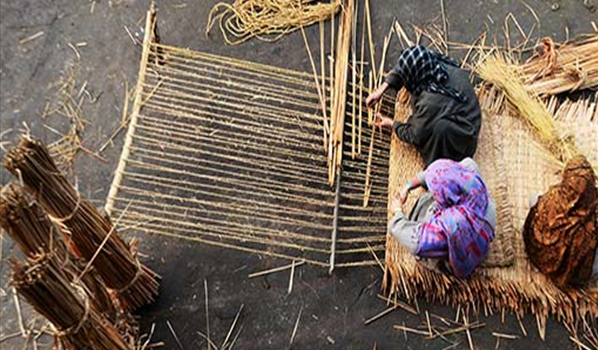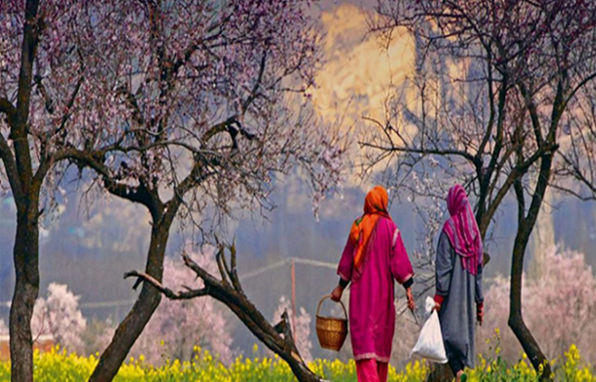CULTURE
Kashmir is the perfect setting for the creation of grass woven traditional items. The variety of grasses which grew in fields, and near the margins of water bodies, etc, since antiquity, played a crucial role in the region’s ecology, economy, and cultural heritage. Some of the indigenously made handicrafts and frequently used traditional grass items of us have contributed a lot to the unique charm of this scenic place. The presence of these traditional grasses in meadows, wetlands, and agricultural fields highlight their diverse role.
As this picturesque region navigates modern challenges, it is essential to recognize the value of these grasses (that artisans put to different items) and work towards their conservation. With the advent of modern & trendy floorings in the markets, the craft has fast vanished and artisans (makers) have left the trade because of low returns.
Once an indispensable part of our culture, particularly in rural areas, these items (easily available, free of cost and eco-friendly items from grasses) are now replaced by the contemporary devices in Kashmir. The weaving of such grass items would start, soon winter would begin. And the most common items included Patij (grass mat), Changij (small circular g-mat), Pulhore (grass woven slipper), Wagoo (grass mat woven by women), etc.
Except for Wagoo, ropes locally known as Gassuv Razh were first woven out of paddy grass known as Dhaan Gasse which was sufficiently available in villages. For rope-weaving, the stacks of grass were soaked completely to make the grass become soft enough to be weaved into a rope. Besides used for Patij, Pulhore, and Changij; ropes were utilized to hook up domestic animals at home vis-à-vis used to tie the bundles of harvested paddy or other grasses, etc.
Once rope weaving was over, would start the making of Patij and Pulhore by men. While men weaved them, women kept themselves busy working on Changij and Wagoo. Changij was used later by women to sit on it, in front of traditional Chulha (hearth) known as Dambur in Kashmir. Besides, it was also used in villages to sun-dry traditional vegetables called Houk Seun ahead of winter.
For Patij weaving, the best time was during heavy snowfall when everyone remained indoors. A massive bundle of grass rope was arranged on a wooden entwined wheel locally known as Karr which would remain available at our edifices in different shapes. Karr size would help in determining the mat breadth. Weaving Patij would start as soon as the ropes were coiled round the Karr with its front portion of ropes tied to a heavy weight. I recall, my Uncle (Patij weaving expert in the village) would generally hold the front side firmly with Nyem, our traditional “Okhli”.
Patij weaving would go on for number of days, till it acquired a cylindrical shape of desired length which was later cut with the scissors in the center, and then its borders were stitched with the help of Korashe (a small stick with a hole on one side for passing hay rope). Considered to be a major avenue of the cultural heritage in rural Kashmir, Patij was later used at home and some of its quota was kept at balcony of the house to generate a steady source of income during winter.
However, Wagoo was costlier because of being smooth, comfortable, durable and warm. It was made in City by lake dwellers locally called Haenz (hanjis) and used by them instead of Patij that was weaved in villages because of the availability of hay grass.
As for our traditional footwear Pulhor; it was also made up of paddy grass and was used to protect one’s feet due the unavailability of modern footwear. Pulhor (grass made slipper) was woven by both men and women at home. It had a great benefit that it neither slipped on mud nor on the snow. Grass was also used as roofing material (thatch) locally called as Cheye Pash for houses-the real reminiscent of our old Kashmir. But now, the same roof tops are made up of colorfully designed tin-metal sheets.
In far-flung areas, people still cherish grass items to keep their culture alive. But, how sad! We now care least about the craft, highly appreciated even during the reign of King Zain-ul-Abideen Budshah, and Mirza Haider. As modernity threatens this rich craft, come; let’s join in contemplating the value of preserving a vanishing heritage.
(Author writes on Kashmir’s cultural ethos, and is a regular columnist. Feedback: [email protected])








